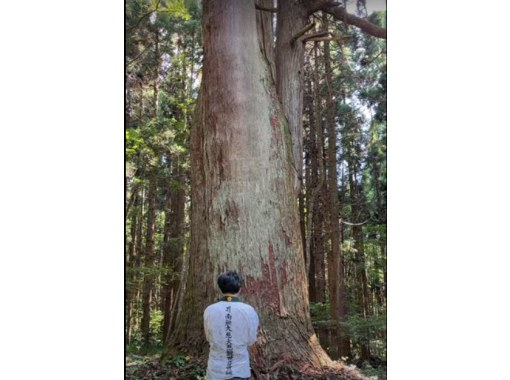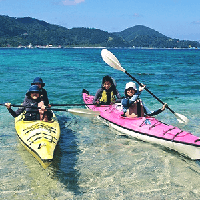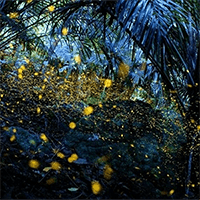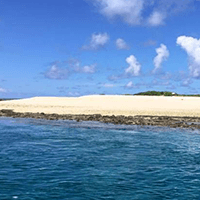- Age 0~Age 100
- 1~2 hours
- 13:00
Have fun learning about tea in a tea-producing area that has been around since the Heian period! You can enter the beautiful tea fields, take photos of yourself as a tea girl, tour the factory, and brew delicious tea in a teapot, all of which can be enjoyed by people of all ages. In May, July, and September, you can also choose to pick tea leaves as an option. You can take the tea leaves home with you, and children's costumes are also available for the popular tea girl experience! Parent-child participation is also recommended. You can access the area by renting a bicycle from JR Sasayamaguchi Station. It takes about 12 minutes to get there while admiring the beautiful tea fields.
- Age 0~Age 90
- 1 Day or more
This healing experience is recommended by the Kishu Koyasan Yokobue Club. You can walk the pilgrimage route with a little effort, cook authentic Buddhist cuisine, and relax at the tea ceremony. You can also combine training and cultural experiences. Considering the purpose and the number of participants, we will have a meeting in advance and decide the plan. For this experience, you will use accommodation facilities within Koyasan.
- Age 10~Age 60
- 3~4 hours
[Greetings to guests] Kumano, the land of rebirth, the holy land of rebirth. By visiting these beautiful yet profound sacred sites and by interacting with the locals, you can look back, realize, and reset yourself. Shingu has an energetic, intense energy to the town itself. That power is also reflected in the Oto Matsuri, a fire festival, and the Mifune Matsuri, an annual festival at Hayatama Taisha Shrine. Touching that high Ki will change your life. In advance, choose the place you want to go and the dragon god you want to meet, and make a plan according to your dreams and wishes. Be objective in your interactions and clarify what you want. The day started after visiting Kamikura Shrine. Afterwards, head to the selected sacred place. By having a resurrection experience that you can feel with your five senses, it first affects your body. For example, touch the cold water of a waterfall and drink it. The waves of holy water circulate and purify the body. “Yummy!” you will exclaim. Since the mind and body are closely connected, the mind opens up in tune with the vibration. Words will come out by receiving aroma & color therapy, personal color diagnosis, counseling, etc. at the sacred place. Then your worries will be sorted out, and you will be freed from the obsessions you made in your head. Stand barefoot on the ground and ground. By connecting with Kumano and the earth, excess electricity and unnecessary emotions that have accumulated in the body will flow, power charging, and the heart will be activated. When my soul is shaken, why do I cry, and I feel happy and want to dance or sing, so I will express it without restraint. Reviving to return to your original self. I will also tell you a message from the dragon god.
- Age 10~Age 60
- 3~4 hours
[Greetings to guests] Kumano, the land of rebirth, the holy land of rebirth. By visiting these beautiful yet profound sacred sites and by interacting with the locals, you can look back, realize, and reset yourself. In Katsuura, Mt. Nachi has been a sacred place for prayers since ancient times, and hot springs with different spring quality due to the activity of magma, as well as gourmet food such as raw tuna, are also attractive. It is a retreat where you can have fun while visiting sacred places, and when you feel like it, you will be purified and receive power.In advance, you can choose the place you want to go and the dragon god you want to meet, and plan a trip according to your dreams and wishes. Be objective in your interactions and clarify what you want. On the day of the event, we started by visiting Hirou Shrine and Nachi Taisha Shrine. Afterwards, head to the selected sacred place. By having a resurrection experience that you can feel with your five senses, it first affects your body. For example, looking up at Nachi Falls will make you exclaim, "Wow!" Since the mind and body are closely connected, the mind opens up in tune with the vibrations of the sacred grounds. By receiving Kumano Aroma & Color Therapy, Personal Color Diagnosis, Counseling, etc. at the sacred place, you will be able to organize your troubles and be freed from the obsessions you have created in your head. Meditate in the trees, stand barefoot on the ground, and ground. By calming the mind and connecting with Kumano and the earth, the excess electricity and unnecessary emotions that have accumulated in the body will flow, power charge, and the heart will be activated. When my soul is shaken, why do I cry, and I feel happy and want to dance or sing, so I will express it without restraint. Reviving to return to your original self. I will also tell you a message from the dragon god. Afterwards, relax in the hot springs.
- Age 10~Age 60
- 3~4 hours
[Greetings to guests] A pilgrimage to Kumano is a trip that will change your life from ancient times. We review the present way of being, salvage the past, and connect to the future. It's amazing how just by visiting Kumano's sacred sites, you can be healed, energized, and full of power. That is the power of Kumano. Let's awaken your own power with various works, therapies, etc. that attract dreams and the future you want to achieve. In the message column in advance, select the place you want to go and the dragon god you want to meet, and make a trip according to your dreams and wishes. Be objective in your interactions and clarify what you want. The day started after visiting Kumano Hongu Taisha. Afterwards, head to the selected sacred place. By having a resurrection experience that you can feel with your five senses, it first affects your body. For example, if you lie down on the earth, the vibrations of the holy land will circulate and purify your body. “Feel good!” you will exclaim. Since the mind and body are closely connected, the mind opens up in tune with the vibration. By receiving therapy and counseling at the sacred place, your worries will be sorted out and you will be freed from the obsessions you made in your head. Stand barefoot on the ground and ground. By connecting with Kumano/Earth, excess electricity and unnecessary emotions that have accumulated in the body will flow, power charge, and heart will be activated. You can feel relieved by hugging a tree that has inspired you, or clear your mind and body by meditating by the river. When my soul is shaken, why do I cry, and I feel happy and want to dance and sing, so I will express it without restraint. It is important to return to your original self. I will also tell you a message from the dragon god.
- Age 16~Age 70
- 3~4 hours
- 09:30 / 14:00
Nozato Kaido, which once served as the gateway to Himeji, and Senba Town, which flourished on the Saigoku Kaido road that runs through Himeji Castle Town, still retain many traces of history and a charming atmosphere. You can easily ride an electric bicycle through narrow roads that are difficult to drive on and roads that are a little tiring to walk on. This is a 3-hour tour that will make you love Himeji even more before or after sightseeing at Himeji Castle. <Schedule AM example> 09:15 Meeting Greeting from the guide, e-bike specification explanation and practice 09:30 Cycling starts! The tour starts from the gateway to Himeji Castle Historical spots from old stories and townscapes that retain the atmosphere of the past Spots to see the spectacular view of Himeji Castle (There is no lunch break) (There are 2-3 places where you can take a toilet break) 12:30 Disbanding After the tour, please enjoy Himeji Station's specialty Eki Soba with an Eki Soba ticket! After the tour ends, you can rent a bicycle for free until 5:00 p.m. if you wish. Enjoy Himeji freely! (The vehicle may be changed depending on the reservation situation) (*) Guides and staff on the day will be able to speak Japanese and English. We are accustomed to dealing with inbound customers.
- Age 13~Age 65
- 5~6 hours
Kuromatsunai Town is a small town with a population of about 2,700, located inland where the Pacific Ocean and the Sea of Japan are closest to each other. In the morning, we left Oshamambe-cho overlooking the Pacific Ocean, ran through the beach of Shizukari, and crossed the pass to Kuromatsunai. Then, leisurely pass through the Satoyama in Kuromatsunai to Suttsu-cho, a town facing the Sea of Japan. Aim for about 50km in a day with a local guide.
- Age 0~Age 100
- 1~2 hours
- 10:10
★This event is not a private event.★★This event will be held jointly with other customers.★This is an experience program where you can learn about sumo, a traditional Japanese culture. We will introduce you to the training content and rules of sumo, allowing you to experience sumo for yourself. The program will be conducted in Japanese, English, or both, depending on your nationality. After the experience, you will enjoy a chanko nabe lunch supervised by a former sumo wrestler. ~ Flow of the day ~ ① Gathering ② Explanation of the history of sumo, training content, decisive moves, prohibited moves, etc. 20 minutes ③ Sumo efforts 10 minutes ④ Challenge a former sumo wrestler (only for those who wish) 10 minutes ⑤ Commemorative photo 5 minutes ⑥ Chanko lunch/Q&A 45 minutes ⑦ Dissolution If you have any questions, please feel free to ask us anything.
- Age 12~Age 100
- 5~6 hours
- 15:30
Shizuoka has flourished as a post town on the Tokaido road since the Edo period and as a tea-producing region. Please enjoy the unique "Chaji" experience that continues to cherish the history and culture of Shizuoka through local daily life and festivals. "Chaji CHAJI ~ Iki~" is a top-class banquet where you can fully enjoy the culture of a post town on the Tokaido road.・Duration: Approximately 5 hours ・Meals: Traveler's Kaiseki ・Traditional performing arts: Either Nagauta, Shamisen or Japanese dance ・General schedule: ⑴ A curator or local guide will introduce and explain the local history and culture of the Tokaido post town, which has been nurtured by the tea industry ⑵ A performance of one of the traditional performing arts, Nagauta, Shamisen or Japanese dance, which has been passed down in the culture of the post town ⑶ Kaiseki cuisine that pairs well with green tea and local sake ⑷ A tea ceremony with local sencha and sweets by a tea farmer or tea master ~Experience flow~ Experience a banquet "Chaji" where you can enjoy "Shizuoka green tea", the number one tea producing region in Japan, and "400 years of Tokaido post town culture" Iki plan *We will pick you up by taxi from Kakegawa Station, Shimada Station, or your accommodation in Kakegawa or Shimada city. ●Meeting place: Fujibun (Kakegawa City) or Sakurai Residence (Shimada City) 15:30●Greetings and explanations 15:30 - 16:00 Introducing the unique story of Tokaido post town culture and tea culture in this area ☆Kawasakaya (Kakegawa City): Guided tour of Hizaka-juku in the Edo period by the Kawasakaya Association and performance of Hizaka Mago Utagi ☆Oigawa Kawagoe Ruins (Shimada City): Guided tour of the Kawagoe system in the Edo period while touring the meeting hall, jin'ya, Sakurai Residence, etc. ●Yorozuya (Kakegawa City) or Sakurai Residence (Shimada City) 16:10 - 17:10 Traditional performing arts performance Either shamisen, nagauta, or Japanese dance ●Fujibun (Kakegawa City) or Sakurai Residence (Shimada City) 17:20 - 18:20 ☆Tea party with local sencha *A recreation of "ame no mochi" (candy rice cake), which is said to have been a favorite of Tokugawa Ieyasu, will be served as a tea snack. *Kappo Uomitsu (Kakegawa City) or Sakurai House (Shimada City) 18:40 - 20:00 ☆Kaiseki cuisine that combines green tea and local sake ☆After greetings, disband around 20:10 *We will take you by taxi to Kakegawa Station, Shimada Station, or your accommodation in Kakegawa or Shimada City. *The itinerary may change depending on the season, weather, and other circumstances, as well as the venue.
- Age 12~Age 100
- Over 6 hours on the day
- 14:00
Shizuoka has flourished as a post town on the Tokaido road since the Edo period and as a tea-producing region. Please enjoy the unique "Chaji" experience that continues to cherish the history and culture of Shizuoka through local daily life and festivals. "Chaji CHAJI ~Hana~" is a top-class banquet where you can fully enjoy the culture of Tokaido post towns. Duration: Approximately 6 hours Meal contents: Kaiseki cuisine for senior retainers Traditional performing arts: Nagauta, shamisen or Japanese dance. Performing arts experience: Experience either shamisen or Japanese dance. Outline schedule: 1. Explanation and guide from producers at tea plantations cultivated using the Chagusaba method, a World Agricultural Heritage System. 2. Explanation and guide from curators and local guides about the history and culture of the Tokaido post towns and tea industry. 3. Performance of one of the traditional performing arts passed down in the post town culture: Nagauta, shamisen or Japanese dance. 4. Kaiseki cuisine that pairs well with green tea and local sake. 5. Tea ceremony with local sencha and sweets by tea farmers or tea masters. ~Experience flow~ Experience a banquet "Chaji" where you can enjoy "Shizuoka green tea", the number one tea producing region in Japan, and "400 years of Tokaido post town culture". Hana Plan *We will pick you up by taxi from Kakegawa Station, Shimada Station, or your accommodation in Kakegawa or Shimada City. 00~17:10 English: ●Meeting place: Fujibun (Kakegawa City) or Sakurai Residence (Shimada City) 14:00●Greetings and explanations Learn about the unique stories of Tokaido post town culture and tea culture in this area 14:00 - 14:20 → (Travel by private vehicle) → ●Tea fields A tea farmer will explain local tea cultivation 14:35 - 15:05 (Tea picking experience depending on the season) → (Travel by private vehicle) → ●Kawasakaya (Kakegawa City) or Sakurai Residence (Shimada City) 15:20 - 16:00 Kawasakaya: Guided tour of Hizaka-juku in the Edo period by the Kawasakaya Association and performance of the Hizaka Mago-uta song Oigawa Kawagoe Ruins: Guided tour of the Kawagoe system in the Edo period while touring the meeting hall, jin'ya, Sakurai Residence, etc. ●Yorozuya (Kakegawa City) or Sakurai Residence (Shimada City) 16:10 - 17:10 Traditional performing arts performance and experience Either shamisen, Nagauta, or Japanese dance ●Fujibun (Kakegawa City) or Sakurai House (Shimada City) 17:20 - 18:20 ☆Tea party with local sencha tea ※A tea snack made with a replica of "ame no mochi" (candy mochi), which is said to have been a favorite of Tokugawa Ieyasu ●Kappo Uomitsu (Kakegawa City) or Sakurai House (Shimada City) 18:40 - 20:00 ☆Kaiseki cuisine with a marriage of green tea and local sake ☆After greetings, disband around 20:10 ※We will take you by taxi to Kakegawa Station or Shimada Station or to your accommodation in Kakegawa or Shimada City. ※The itinerary may change depending on the season, weather, and other circumstances, as well as the venue.
- Age 12~Age 100
- Over 6 hours on the day
- 13:00
Shizuoka has flourished as a post town on the Tokaido road since the Edo period and as a tea-producing region. Please enjoy the unique "Chaji" experience that continues to cherish the history and culture of Shizuoka through local daily life and festivals. "Chaji CHAJI ~ Miyabi ~" is a top-class banquet where you can fully enjoy the culture of a Tokaido post town. Duration: Approximately 7 hours Meal content: Lord's kaiseki cuisine Traditional performing arts: High-class kimono, Nagauta, shamisen, and Japanese dance Performance experience: Shamisen and Japanese dance experience Outline schedule: 1. Explanations and tours from producers at tea plantations cultivated using the Chagusaba method, a Globally Important Agricultural Heritage System 2. Curators and local guides introduce the history and culture of this Tokaido post town, nurtured by the tea industry 3. A performance of traditional performing arts that are passed down in post town culture, such as Nagauta, shamisen, and Japanese dance 4. Experience the kimono culture that has been cultivated in Shimada-juku, famous for its obi festival that has been passed down since the Edo period, by trying on a kimono 5. Kaiseki cuisine that pairs well with green tea and local sake ⑹ Tea ceremony with local Sencha tea and sweets by a tea farmer or tea master. ~Experience process~ *We will pick you up by taxi from Kakegawa Station, Shimada Station, or your accommodation in Kakegawa or Shimada City. 00~17:10 English: ●Meeting place: Fujibun (Kakegawa City) or Sakurai Residence (Shimada City) 13:00●Greetings and explanations Learn about the unique stories of Tokaido post town culture and tea culture in this area 13:00 - 13:20 → (Travel by private vehicle) → ●Tea fields A tea farmer will explain about local tea cultivation 13:30 - 14:10 (Tea picking experience depending on the season) → (Travel by private vehicle) → ●Kawasakaya (Kakegawa City) or Sakurai Residence (Shimada City) 14:30 - 15:00 Kawasakaya: Guided tour of Hizaka-juku in the Edo period by the Kawasakaya Association and performance of the Hizaka Mago-uta song Oigawa Kawagoe Ruins: Guided tour of the Kawagoe system in the Edo period while touring the meeting hall, jin'ya, Sakurai Residence, etc. ●Yorozuya (Kakegawa City) or Sakurai Residence (Shimada City) 15:10 - 17:10 Traditional performing arts performance and experience Shamisen, Nagauta, and dancing 15:20 - 16:20 ☆ Kimono dressing experience (limited number) 16:20 - 17:20 ● Fujibun (Kakegawa City) or Sakurai House (Shimada City) 17:20 - 18;20 ☆ Tea ceremony with local sencha ※ A reproduction of "ame no mochi" (candy mochi), which is said to have been a favorite of Tokugawa Ieyasu, is served as a tea snack ● Kappo Uomitsu (Kakegawa City) or Sakurai House (Shimada City) 18:40 - 20:00 ☆ Kaiseki cuisine with green tea and local sake ☆ After greetings, disband Around 20:10 * We will take you by taxi to Kakegawa Station or Shimada Station or your accommodation in Kakegawa City or Shimada City. * The itinerary may change depending on the season, weather, and other circumstances, and depending on the venue.
- Age 0~Age 100
- 2~3 hours
- 10:00 / 13:30
<Introducing an unknown old-style folk house cafe in Yokohama♪> When you think of Yokohama, you probably imagine a big city, right? In fact, Yokohama has many historic buildings with a long history, and cafes using old-style houses are secretly booming! Why is there a cafe here? What is the history of this building? We will tell you the inside story of this place and the story behind the birth of the cafe as we head to the location. After you have had a wonderful time, we will take you to the nearest station of your choice. Experience the true charm of Yokohama! ★Make your reservation early!!
- Age 3~Age 80
- 5~6 hours
- 09:15
We will travel around various places in a private car (taxi). From the "Cup Noodle Museum", you will have a guided tour of the "Kobayashi Ichizo Memorial Museum", a great man representing Ikeda, and the "Ikeda Castle Ruins". In the first part, you will have the opportunity to experience copying sutras and zazen at "Kyuanji Temple", which was founded by Gyoki Bodhisattva, was a temple established by Emperor Konoe, and was visited by Toyotomi Hideyoshi. For lunch, you will enjoy a specially planned "Nichireku Special" lunch at Hirakawa River. In the second part, you will visit the "Oshima Tsumugi Museum" to see the workshop and exhibits, take photos wearing Oshima Tsumugi, soothe yourself in the hot springs at "Fushiohkaku", and enjoy a "seasonal bento" lunch. Enjoy a day in Ikeda, Osaka!
- Age 10~Age 80
- 2~3 hours
- 10:00
This is a half-day sightseeing course that visits the historic Chozenji Temple in Takehara City, Hiroshima Prefecture, Aki's Little Kyoto. This is a plan that includes a taxi meeting at Takehara Station. The tour runs every Tuesday and Wednesday. After arriving at Chozenji Temple grounds, you will be welcomed with a Nembutsu prayer and a welcome drink by the chief priest, and then tour the Ishiyama Battle Memorial Hall within the grounds with commentary from the chief priest. Here, the flag of the Ishiyama Battle Army and the list of those killed in battle at Fort Amagasaki during the Battle of Ishiyama are preserved. This flag was used during the ``Battle of Ishiyama'' (1570-1580), a battle between Oda Nobunaga and his followers at Honganji Temple.At the request of the third chief priest Enzai, his followers, mainly members of the Fujiwara clan, organized Kihata-gumi, and along with the Mori army, they formed the Kihata-gumi. After setting sail and going to support Ishiyama, we will enjoy copying sutras in a vault overlooking a Japanese garden with the motif of ``heart.'' Afterwards, enjoy copying sutras in front of a beautiful Japanese garden. Sutra copying is a form of meditation. Meditation time will be a time to heal your everyday stress. Please enjoy authentic Chozenji Buddhist cuisine along with the beautiful garden and furniture. This is a special cuisine and space that can only be enjoyed here. ~Flow of the day~ 10:00 Gather at JR Takehara Station. Move to Chozenji. Sutra copying experience and visit to the Ishiyama Battle Memorial Museum, guided lunch at 11:30 AM Shojin Kaiseki cuisine while looking at the magnificent folding screen and Japanese garden After this course, you will have free time. We recommend a free stroll through the Takehara Old Townscape Preservation District. Takehara City (Hiroshima Prefecture) Townscape Preservation District, known as the Japan Heritage ``Takehara Old Townscape Preservation District'' and ``Aki's Little Kyoto'', has been designated as one of the top 100 cityscapes, and was also designated as a Japan Heritage Site in 2019. Ta. Takehara is said to have first been cultivated as a manor land for Shimogamo Shrine in Kyoto during the Heian period under the Private Property Law of Konta Eiten. During the Muromachi period, Mori Motonari's third son Takakage (who was adopted by the Kobayakawa family and became Takakage Kobayakawa) spent his childhood there. Takakage was one of the people who received the ``Three Arrows' teachings'' from Motonari and supported the Mori clan system. Later, in the late Edo period, it developed through salt fields and sake brewing, and it is said that it boasted an 80% share of Hiroshima prefecture's salt production at the time. There are three sake breweries: Taketsuru Sake Brewery, Fujii Sake Brewery, and Nakao Jozo. Masataka Taketsuru, the founder of Nikka Whiskey, known as the ``father of Japanese whisky,'' is from Takehara. Taketsuru Sake Brewery, Masataka's birthplace, still operates in the townscape preservation district to this day. Around this time when salt and sake were developing, Rai Sanyo, a Confucian scholar and author of ``Japanese Foreign History,'' which had a great influence on the patriots at the end of the Edo period, was active. The former home of Sanyo's grandfather, Kiyoshi Yoriyoshi, is located in the townscape preservation district. (Excerpt from the Japan Historical Travel Association) At the annual Takehara Longing Road, the town is beautifully illuminated with candlelight and bamboo lanterns set in the townscape preservation district. The atmosphere of the old house leaking through the lattice door is also very atmospheric, giving you the illusion of having traveled back in time.
- Age 10~Age 50
- 3~4 hours
- 10:00
"Enjoy the scenery of the UNESCO World Heritage Shirakami-Sanchi" Walk the mountains of Noshiro in full pilgrimage attire with Noen Haruharu, a guide from Ryusenji Temple! You can hear about history and faith from your guide, and about trees and flowers from Noen Haruharu. Experience Buddhism by walking through the mountain scenery of the four seasons. Pick seasonal wild vegetables, cook them yourself, and eat them. Enjoy seasonal wild vegetables with rice balls, pickles, and miso soup. At the end, there is a 15-minute Buddhist talk in English. ~Experience flow~ 9:00 Mountain hiking Content changes depending on the season Pick wild vegetables Take a break at the peak and drink Noen Haruharu's herbal tea Heart Sutra reading in the hall (reading sutras together) 12:00 Return to Ryusenji Temple Cook wild vegetables yourself Don't worry, we will prepare extra if there is not much to pick. Lunch is rice balls with wild vegetables, miso soup, and smoked daikon radish while looking at the Shirakami Mountains. You can listen to a 15-minute talk on Buddhism in English from the head priest. Until 13:00 Q&A We will answer any questions you may have.
最近チェックしたプラン
Please wait a moment
![[Hyogo, Tamba Sasayama] Learn about tea in a fun way at Japan's oldest tea place!の画像](https://img.activityjapan.com/10/57279/10000005727901_ntZ3nnUe_3.jpg?version=1735187222)
![[Wakayama / Koyasan] [1 night 2 days] Petit retreat at Koyasan ☆ Arrangeable and let's have your own healing experience ♪の画像](https://img.activityjapan.com/10/43538/10000004353801_mF6wAgG0_3.jpg?version=1659582245)
![[Wakayama/ Tanabe] Go see Ryujin ~ Mikumano Retreat ~ A journey starting from Shinguの画像](https://img.activityjapan.com/10/43691/10000004369101_NJ2VqCqG_3.png?version=1660276208)
![[Wakayama/Tanabe] Go to see the dragon god-Mikumano Retreat-Trip starting from Katsuuraの画像](https://img.activityjapan.com/10/43667/10000004366701_NJ2VqCqG_3.png?version=1660123449)
![[Wakayama/Tanabe] Go to see the dragon god-Mikumano Retreat-Trip starting from Kumano Hongu Taishaの画像](https://img.activityjapan.com/10/43662/10000004366201_NJ2VqCqG_3.png?version=1660116729)
![[Hyogo, Himeji] e-bike cycling tour: Touring Himeji Castle Town along the old roads [Recommended for those who want to know more about Himeji] ◎ Includes a ticket for Himeji Station's specialty, Eki Soba!の画像](https://img.activityjapan.com/10/48336/10000004833601_b3FcpwT1_3.jpg?version=1683103983)
![[Kuromatsunai Town, Hokkaido] Coast to Coast Ride ~ From the Pacific Ocean to the Sea of Japan ~の画像](https://img.activityjapan.com/10/38766/10000003876601_okGXjG0D_3.jpg?version=1680864242)
![[Ryogoku, Tokyo] Experience traditional Japanese culture <Sumo show & chanko lunch (held in English)> "Would you like to try your hand at sumo?"の画像](https://img.activityjapan.com/10/49761/10000004976101_Rfh3BdJd_3.jpg?version=1708242722)
![[Shizuoka/Kakegawa] Experience the "Chaji" banquet to enjoy "Shizuoka green tea" from Japan's number one tea producing region and "400 years of Tokaido post town culture" with the "Iki Plan"の画像](https://img.activityjapan.com/10/56772/10000005677201_AVWlGGNt_3.jpg?version=1730975102)
![[Shizuoka/Kakegawa] Experience the "Chaji" banquet to enjoy "Shizuoka green tea" from Japan's number one tea producing region and "400 years of Tokaido post town culture" Hana Planの画像](https://img.activityjapan.com/10/56748/10000005674801_AVWlGGNt_3.jpg?version=1730976666)
![[Shizuoka/Kakegawa] Experience the "Chaji" banquet to enjoy "Shizuoka green tea" from Japan's number one tea producing region and "400 years of Tokaido post town culture" Miyabi planの画像](https://img.activityjapan.com/10/56746/10000005674601_AVWlGGNt_3.jpg?version=1730976485)
![[Kanagawa/Yokohama] Relax your soul in a traditional Japanese cafe. We'll take you to a historic Japanese house! Is this really Yokohama?の画像](https://img.activityjapan.com/10/54896/10000005489601_lpXgdgDW_3.jpg?version=1718882836)
![[Osaka, Ikeda] Osaka Ikeda Experience Tour! Part 1 and Part 2の画像](https://img.activityjapan.com/10/57609/10000005760901_qgEqCyiL_3.jpg?version=1738037889)
![[Hiroshima/Takehara City] [Meal and taxi included plan] Aki's Little Kyoto "Chozenji and History" Have a special time with beautiful temples and delicious vegetarian cuisine!の画像](https://img.activityjapan.com/10/45708/10000004570801_zupYFKe4_3.JPG?version=1702712583)








